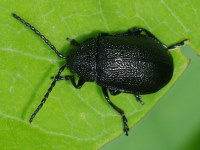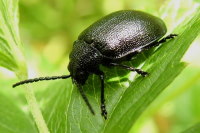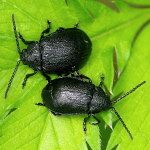Phylum Arthropoda (Arthropods) ➔ Subphylum Hexapoda (Hexapods) ➔ Class Insecta (Insects) ➔ Order Coleoptera (Beetles) ➔ Family Chrysomelidae (Leaf beetles)
Galeruca (Galeruca) tanaceti (Linnaeus, 1758)
Rainfarn-Blattkäfer
Synonyms and other combinations:
Chrysomela tanaceti Linnaeus, 1758 | Tenebrio tristis Scopoli, 1863 | Galleruca declivis Joannis, 1866 | Galleruca bonvouloiri Joannis, 1866 |
Classification:
Galeruca tanaceti belongs to the subfamily Galerucinae, tribe Galerucini.Distribution:
Palearctic, introduced into North America.Habitat:
Dry and sunny biotopes: grassland, high perennial meadows, ruderal meadows.Description:
Length 6 - 10 mm; winged, always black, slightly shiny species with arched elytra; elytra coarsely punctured and without distinct ribs; elytra with broad and deep lateral groove surrounding the shoulder bulge at the base; lateral edges of the elytra visible from above; pronotum deeply impressed at front corners; front corners of pronotum blunt or rounded.Similar species:
In the similar Galeruca pomonae the upper side is mostly brown, only rarely black. The elytra are more clearly ribbed.Biology:
Galeruca tanaceti is a warmth loving species. At least a part of the population is airworthy in contrast to most closely related species. Adult beetles can be found from June to October/November.The eggs are attached by the females in packages to higher stems or leaves in the period from September to November and covered with a fast hardening, foamy, protective secretion. The pregnant females climb up the stems to lay their eggs, as their enlarged abdomen makes them too heavy to fly. The eggs overwinter. After hatching, the larvae migrate to their fodder plants. They develop from April to June and pass through 3 larval stages. The larvae mostly feed on composites (Asteraceae), such as common yarrow (Achillea millefolium), brown knapweed (Centaurea jacea) and common tansy (Tanacetum vulgare), sometimes also on plants of the pink family (Caryophyllaceae), such as greater stitchwort (Stellaria holostea) and field chickweed (Cerastium arvense). They pupate in the foliage layer on the ground or in small cavities. 3 weeks later, after the pupal period, the new generation hatches at the end of June. The imagines feed polyphagously on the host plants of the larvae and also on various crops such as potatoes, beets, cabbage and beans.
Natural enemies:
The chalcid wasp Oomyzus galerucivorus (Chalcidoidea, Eulophidae) parasitizes the eggs of Galeruca tanaceti.The larvae of the ground beetle Lebia cruxminor (Coleoptera, Carabidae) develop as ectoparasites of pupae of Galeruca tanaceti and further leaf beetles.
References, further reading, links:
- Rheinheimer, Joachim, & Hassler, Michael: Die Blattkäfer Baden-Württembergs, 2018, 928 pages, Kleinsteuber Books (Karlsruhe), ISBN 978-3-9818110-2-5
- Arved Lompe: Die Käfer Europas - Ein Bestimmungswerk im Internet
- Nothern Ireland Priority Species: Species list
- Altica sp.
- Bruchus sp.
- Cassida nebulosa
- Cassida sp.
- Cassida stigmatica
- Cassida vibex
- Cassida vibex/bergeali
- Chrysolina lucidicollis
- Chrysolina oricalcia
- Chrysolina sp.
- Chrysolina sturmi
- Chrysolina varians
- Chrysomela tremula
- Coptocephala sp.
- Crepidodera aurea
- Crepidodera fulvicornis
- Cryptocephalus moraei
- Cryptocephalus nitidus
- Cryptocephalus pusillus
- Cryptocephalus sp.
- Donacia cinerea
- Donacia marginata
- Donacia versicolorea
- Galeruca tanaceti
- Galerucella s.l.
- Gonioctena decemnotata
- Gonioctena quinquepunctata
- Gonioctena sp.
- Gonioctena viminalis
- Lema cyanella
- Neocrepidodera sp.
- Oulema melanopus/duftschmidi
- Oulema obscura
- Pachybrachis sp.
- Phratora sp.
- Plagiosterna aenea
- Plateumaris sp.
- Podagrica fuscicornis
- Psylliodes sp.
- Sphaeroderma sp.
- Gonioctena quinquepunctata/intermedia
- Alder Leaf Beetle
- Ant Bag Beetle
- Barley Flea Beetle
- Brassy Willow Leaf Beetle
- Broad Bean Weevil
- Case-bearing Leaf Beetles
- Colorado Potato Beetle
- Dead-nettle Leaf Beetle
- Elm Leaf Beetle
- Four Spotted Leaf Beetle
- Green Dock Beetle
- Green Tortoise Beetle
- Horseradish Flea Beetle
- Imported Willow Leaf Beetle
- Iris Flea Beetle
- Lily Leaf Beetle
- Plantain Leaf Beetle
- Poplar Leaf Beetle
- Skullcap Leaf Beetle
- Spotted Asparagus Beetle
- Spotted Willow Leaf Beetle
- St John's-wort Leaf Beetle
- Thistle Tortoise Beetle
- Turnip Flea Beetle
- Two-tone Reed Beetle
- Viburnum Leaf Beetle
- Western Grape Rootworm
- Wheat Flea Beetle
- Willow Flea Beetle
- Willow Leaf Beetle


